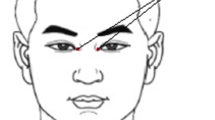Abstract
Objective
To explore a proper acupuncture treatment protocol for dry eye syndrome (DES), by comparing the therapeutic effects between ordinary acupuncture and electroacupuncture (EA).
Methods
Forty-seven eligible subjects with DES were randomized into an acupuncture group (n=23) and an EA group (n=24). With the same acupoint formula, the acupuncture group was treated with ordinary acupuncture, and the EA group was treated with ordinary acupuncture plus electrical stimulation. After a treatment course, eye symptom score, Schirmer I test (SIT), Break-up Time (BUT) of tear film, Corneal Fluorescein Staining (CFS), and Visual Analogue Scale (VAS) were adopted in evaluation and comparison of the two groups.
Results
The total effective rate was 79.2% in the EA group versus 56.5% in the acupuncture group, and the difference was statistically significant (P<0.05). After treatment, both groups had marked improvements in eye symptom score, SIT, BUT, CFS, and VAS values (P<0.001); the EA group was better than acupuncture group in improving eye symptom score and SIT value (both P<0.05); the differences were insignificant in comparing VAS, BUT and CFS results between the two groups (P>0.05).
Conclusion
Both EA and ordinary acupuncture are effective in treating DES, but EA is better than ordinary acupuncture in improving eye symptom and SIT score.
Similar content being viewed by others
References
Li FM. China Ophthalmology. Beijing: People’s Medical Publishing House, 2004: 1153–1161.
Schein OD, Munoz B, Tielsch JM, Bandeen-Roche K, West S. Prevalence of dry eye among the elderly. Am J Ophthalmol, 1997, 124(6): 723–728.
Deng XG, Sun QN, Gao Y. Clinical characteristics of 435 patients with dry eye syndrome. Yanke Xin Jinzhan, 2008, 28(10): 763–765.
State Administration of Traditional Chinese Medicine. Criteria of Diagnosis and Therapeutic Effects of Diseases and Syndromes in Traditional Chinese Medicine. Nanjing: Nanjing University Press, 1994: 102.
Hua PD. Treatment of Bai Se Zheng based on syndrome differentiation. Zhongguo Zhongyi Yanke Zazhi, 2004, 3(14):166.
Zhong XN, Cao QX. Clinical observation on treatment of 40 cases of dry eye syndrome based upon syndrome differentiation. Zhejiang Zhongyi Zazhi, 2008, 43(9): 521.
Gao WP, Wang J, Zhang Y. Therapeutic observation on treatment of 31 cases of aqueous-deficient dry eye syndrome with acupuncture. Xin Zhongyi, 2007, 39(6): 41–42.
Wei LX, Yang W, Wang HC, Ding RQ. Clinical observation on treatment of 40 cases of dry eye syndrome with acupuncture-moxibustion. Zhongguo Zhongyiyao Xinxi Zazhi, 2010, 17(5): 65–66.
Ma XP, Yang L, Mo WQ, Shi Z, Zhao CY. Summary on clinical experience of acupuncture treating dry eye syndromes. J Acupunct Tuina Sci, 2009, 7(3): 171–174.
Shi L, Wang YL. Research progress of the effects of sex hormone on the structure and function of tear film. Liaoning Zhongyiyao Daxue Xuebao, 2010, 12(2): 108–110.
Author information
Authors and Affiliations
Corresponding author
Additional information
Author: Guo Meng-hu, M.M.
Rights and permissions
About this article
Cite this article
Guo, Mh., Cui, Ec., Li, Xy. et al. Diverse needling methods for dry eye syndrome: A randomized controlled study. J. Acupunct. Tuina. Sci. 11, 84–88 (2013). https://doi.org/10.1007/s11726-013-0662-9
Received:
Published:
Issue Date:
DOI: https://doi.org/10.1007/s11726-013-0662-9



